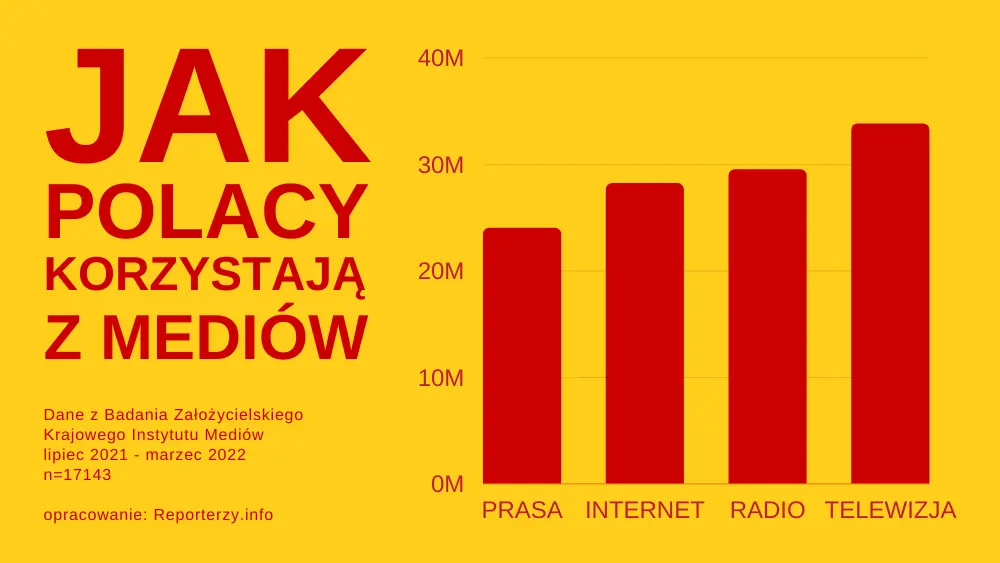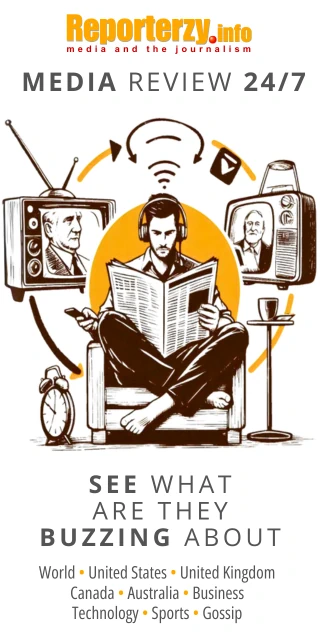 source: National Media Institute, analysis: Reporterzy.info, declarative data for the three months preceding the survey
source: National Media Institute, analysis: Reporterzy.info, declarative data for the three months preceding the surveyThe National Media Institute’s Establishment Survey provides insight into how and how often Poles use traditional and electronic media. Surveyors examined what devices people have at home and what they can access at work or school. The results are as follows:
- Access to TV: 92.0%
- Access to radio: 80.3%
- Access to a computer/tablet: 66.0%
- Access to a mobile phone/smartphone: 88.5%
However, access to a media device does not necessarily mean it is used regularly.
Television
In the 30 days preceding the survey, 90.2% of respondents reported watching television. This translates to 33.1 million Poles, but it’s only 96% of those with access to a TV. Conclusion: two million Poles could watch linear TV but choose not to.
In a longer, three-month period, 92.1% of respondents confirmed watching TV, equating to nearly 33.8 million people. Among age groups, those aged 65+ are the most frequent TV viewers.
- TV viewership by age group
- 4-9 years: 91.5%
- 10-15 years: 95.2%
- 16-24 years: 88.1%
- 25-34 years: 87.0%
- 35-44 years: 90.4%
- 45-54 years: 93.0%
- 55-64 years: 95.2%
- 65+ years: 95.9%
Radio
Radio listening was reported by 75.2% of respondents, meaning that 27.6 million people listened to the radio at least once in the past month. Among radio owners, nearly 8% did not turn on their device even once during the month before the survey.
In a three-month period, the number of radio listeners increases significantly, reaching 80.4% of the population, or 29.5 million people - 1.9 million more than in the one-month period. Radio is least popular among teenagers and most popular among those aged 35-44.
- Radio listenership by age group
- 4-9 years: 71.7%
- 10-15 years: 65.7%
- 16-24 years: 78.5%
- 25-34 years: 83.5%
- 35-44 years: 85.9%
- 45-54 years: 84.4%
- 55-64 years: 82.4%
- 65+ years: 77.9%
Internet
At least 76.8% of respondents use the internet occasionally. In a monthly timeframe, internet users slightly outnumber radio listeners at 28.2 million. According to the National Media Institute, the devices used to access the internet include:
- 26.4 million mobile phone owners (93.9% of internet users)
- 23.6 million computer and tablet owners (83.8% of internet users)
- 15.8 million Smart TV owners (56.2% of internet users)
Over three months, the number of internet users grows by just 300,000, indicating that those who use the internet tend to do so regularly. Among those aged 10 to 50, almost everyone surfs the web. However, over a three-month period, internet usage slightly trails radio usage.
- Internet usage by age group
- 4-9 years: 77.6%
- 10-15 years: 98.6%
- 16-24 years: 99.1%
- 25-34 years: 99.1%
- 35-44 years: 96.5%
- 45-54 years: 89.0%
- 55-64 years: 68.3%
- 65+ years: 28.7%
Print Media
Reaching for newspapers or magazines at least once a quarter is reported by 65.7% of respondents, equating to 24 million readers. Nearly half of this group also reads online editions. Over 11.3 million people, or 31% of the population, read e-publications. The older the age group, the higher the popularity of print media, with readership reaching up to three-quarters among the oldest Poles.
- Print readership by age group
- 4-9 years: 24.6%
- 10-15 years: 45.3%
- 16-24 years: 65.0%
- 25-34 years: 64.9%
- 35-44 years: 69.4%
- 45-54 years: 73.7%
- 55-64 years: 75.3%
- 65+ years: 72.8%
* * *
The National Media Institute’s Establishment Survey was conducted between July 2021 and March 2022 on a representative sample of 17,143 people aged 4 and older. Full results are available at https://kim.gov.pl/wyniki-badan/
COMMERCIAL BREAK
New articles in section Media industry
Why do we believe fakes? Science reveals the psychology of virals
KFi
Why do emotions grab more attention than evidence, and why can a fake authority overshadow scientific data? Researchers from Warsaw University of Technology, Jagiellonian University, and SWPS University in Poland sought the answers. Here are their findings.
Investigative journalism in Europe. Newsrooms face pressure
KFi, Newseria
Media and political representatives point to the difficult situation of investigative journalism in Europe. Newsrooms are reluctant to invest in this segment due to high costs and the large amount of time and effort required. Most of all, however, they fear legal proceedings.
Energy under attack. Disinformation threatens Poland’s power transition
KFi
One in five online messages about energy may be fake. Between 2022 and 2025 nearly 70,000 publications warning and condemning disinformation in this strategic sector were recorded in Polish media. They generated a reach of 1.19 billion impressions.
See articles on a similar topic:
Radio Fanatics. Who Listens for One-Third of the Day?
Bartłomiej Dwornik
One in five listeners now spends over 8 hours daily listening to the radio, according to data from the Radio Track study. Since the beginning of the year, the number of these avid listeners has grown by 300,000.
Influencers Earn Too Much. No Fluff Jobs Report
KrzysztoF
According to nearly 70% of Poles, influencers earn too much, and 54% feel the least affection for them out of all professions. Only politicians receive equally low regard among respondents surveyed by No Fluff Jobs. On the other hand, nurses and… farmers are considered underpaid.
Russian Propaganda. Debunk.org Report on Moscow's Disinformation Scale
BARD, PAP Mediaroom
In 2022, the Russian Federation allocated approximately 143 billion rubles to mass media (equivalent to 1.9 billion US dollars), exceeding the planned budget by 25%. For the current year, the Kremlin's budget for this sector is set at 119.2 billion rubles (1.6 billion dollars).
Selfish Trap: A New Social Influence Technique
Krzysztof Fiedorek
Three psychologists from SWPS University have described a social influence method suggesting people are more willing to complete a task if it highlights a quality important to them, such as loyalty, intelligence, or rationality.






























